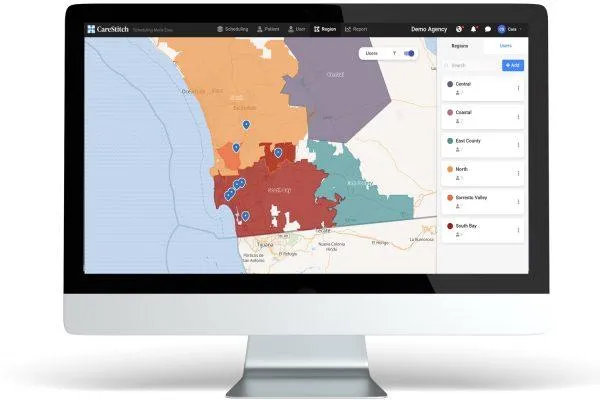THE SOLUTION FOR A RESOURCE-STRAPPED HOME HEALTH INDUSTRY
Use CareStitch’s care coordination platform to simplify scheduling, improve communication, and increase your team’s efficiency.


THE SOLUTION FOR A RESOURCE-STRAPPED HOME HEALTH INDUSTRY
Use CareStitch’s care coordination platform to simplify scheduling, improve communication, and increase your team’s efficiency.
Empower home health schedulers to make better decisions when assigning cases.
Give your entire workforce the right tools to help your home health agency control its costs.


Actively drive down costs with every decision
Using data-driven insights, our software gives your schedulers and mobile workforce the information they need to make better decisions. Align your workforce with your agency’s goals: keep costs down, simplify decision making, and reduce mistakes.
Give your workforce the right tools to help you save time and money
Increase the capacity of each scheduler
Achieve cost savings with less manual work and more automation
Reduce the tedious work that takes 80% of your time and focus on the 20% that improves your relationships with your mobile workforce. Leave the boring stuff to the computers.


Increase the capacity of each scheduler
Achieve cost savings with less manual work and more automation
Reduce the tedious work that takes 80% of your time and focus on the 20% that improves your relationships with your mobile workforce. Leave the boring stuff to the computers.


Improve your care coordination across the entire team
Use HIPAA-compliant, patient-centric chat to have intelligent conversations
The entire team on channels automatically created for each patient with well-organized information directly in front of you? It isn’t just a dream. CareStitch allows your team to coordinate easily without all the back and forth between systems.
With CareStitch, you can be confident in your agency’s compliance.

Map-based Appointment Productivity System (MAPS)
MAPS is a revolutionary map-based scheduling visualization tool giving real-time visibility into clinician & patient distribution on a map.
This feature set makes it easier than ever to optimize resource utilization, reduce travel and maximize efficiency.
Securely communicate with your mobile workforce
Utilize secure, HIPAA compliant chat channels to discuss patient information and coordinate care with your mobile workforce.
Resource utilization and overtime risk in one place
Analyze resource utilization within and across different disciplines and improve your resource management to minimize overtime risk.
Easy 3 step process of case submission to case assigned
Fill out request information. A time and location based algorithm automatically matches the right clinician and then the patient fulfillment request is securely transmitted.
Region management centralized in the platform
CareStitch makes it easy to manage who works in which region. Set up a region, define which zip codes that region covers, and assign clinicians to that region.
Greater visibility for tracking all active case requests
Have full awareness of what’s going on with all outstanding case requests. An alert is shown when an action is needed.
Broadcast case request to appropriate field staff at once
The system will automatically filter to the right clinicians that meet the criteria you set. Clinicians are organized into different priority groups and requests are sent out to them based on the scheduled times your organization sets.

Productivity

Visibility

Collaboration
The most powerful mobile clinician workforce tool, see why.
Get the right tools. Start driving down costs for your home health agency today.

Committed to Helping Our Clients Succeed
Lorem ipsum dolor sit amet, consectetur adipiscing elit. In convallis turpis efficitur enim efficitur pulvinar. Nunc erat nibh, tempor quis volutpat eu, consectetur at ante. Curabitur venenatis orci sed auctor sollicitudin. Curabitur feugiat justo mauris, eget finibus tortor congue non. Donec feugiat mattis nisl et semper. Nulla rutrum est ac iaculis bibendum.

Kim Wexler

Lorem ipsum dolor sit amet, consectetur adipiscing elit. Quisque nisi nunc, tincidunt non nibh non, ullamcorper facilisis lectus. Sed accumsan metus viverra turpis faucibus, id elementum tellus.

Billy Jackson

Lorem ipsum dolor sit amet, consectetur adipiscing elit. Quisque nisi nunc, tincidunt non nibh non, ullamcorper facilisis lectus. Sed accumsan metus viverra turpis faucibus, id elementum tellus.
Read Our Latest Blogs

Are Agencies Scheduling The Right Way?
For agencies, scheduling clinicians to fulfill patient cases can be stressful and error-prone as they navigate a maze of concurrent text messages, emails and phone conversations with their mobile clinicians.
Agencies end up managing bottlenecks rather than work assignments and it rapidly starts to overshadow the primary mission of the agency: providing exceptional care to patients quickly and without hassle.
Here is the typical case fulfillment workflow:
A referral comes in through either fax, phone or electronic means.
Intake receives the referral and inputs the information into the EMR
The referral is pushed to either a dedicated scheduler, or intake takes on the task of scheduling to assign the patient to the appropriate clinician.
The scheduler identifies which clinicians meet all the patient criteria; such as the right skill set, location, availability, gender, language, and more.
Then begin the texts, emails and phone calls to find the first clinician who is in the right region, is the right discipline, has the right specialties and meets all the necessary constraints the patient requires.
Unfortunately, with little visibility into the other end of these texts and emails and faced with an urgent request, schedulers often need to hedge their bets and find backups — so they send out more texts and emails to other clinicians.
Now it’s a juggling act of concurrent streams of communication that quickly become overwhelming — all just to find someone who can see the patient. At times this job starts to feel more like air traffic control!!
This stress can lead to turnover and a high cost of re-training. When scheduling staff is lost, often times knowledge about region assignments, clinician specialties and preferences goes with them. If a scheduler calls in sick, or quits unexpectedly, it creates headaches trying to find an adequate substitute who can successfully deliver the right clinician to the right patient in a short amount of time.
Do these issues sound familiar?
These issues are familiar to many home health, home care and private duty agencies. This cumbersome scheduling process made a lot of sense when they were first established. But given the strides in technological advancement over the last decade, we really need to take a step back and ask ourselves: Is this still the right way to assign patients?


LinkedIn